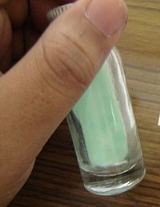
Lowenstein-Jensen medium
Overview
Growth medium
A growth medium or culture medium is a liquid or gel designed to support the growth of microorganisms or cells, or small plants like the moss Physcomitrella patens.There are different types of media for growing different types of cells....
specially used for culture of Mycobacterium
Mycobacterium
Mycobacterium is a genus of Actinobacteria, given its own family, the Mycobacteriaceae. The genus includes pathogens known to cause serious diseases in mammals, including tuberculosis and leprosy...
, notably Mycobacterium tuberculosis
Mycobacterium tuberculosis
Mycobacterium tuberculosis is a pathogenic bacterial species in the genus Mycobacterium and the causative agent of most cases of tuberculosis . First discovered in 1882 by Robert Koch, M...
.
When grown on LJ medium, M. tuberculosis appears as brown, granular colonies (sometimes called "buff, rough and tough"). The media must be incubated for a significant length of time, usually four weeks, due to the slow doubling time of M. tuberculosis compared with other bacteria (15-20 hours).
The usual composition as applicable to Mycobacterium tuberculosis
Mycobacterium tuberculosis
Mycobacterium tuberculosis is a pathogenic bacterial species in the genus Mycobacterium and the causative agent of most cases of tuberculosis . First discovered in 1882 by Robert Koch, M...
is:
- Malachite greenMalachite greenMalachite green is an organic compound that is used as a dyestuff and has emerged as a controversial agent in aquaculture. Malachite green is traditionally used as a dye for materials such as silk, leather, and paper...
- GlycerolGlycerolGlycerol is a simple polyol compound. It is a colorless, odorless, viscous liquid that is widely used in pharmaceutical formulations. Glycerol has three hydroxyl groups that are responsible for its solubility in water and its hygroscopic nature. The glycerol backbone is central to all lipids...
- AsparagineAsparagineAsparagine is one of the 20 most common natural amino acids on Earth. It has carboxamide as the side-chain's functional group. It is not an essential amino acid...
- Potato starchPotato starchPotato starch is starch extracted from potatoes. The cells of the root tubers of the potato plant contain starch grains . To extract the starch, the potatoes are crushed; the starch grains are released from the destroyed cells...
- CoagulatedCoagulationCoagulation is a complex process by which blood forms clots. It is an important part of hemostasis, the cessation of blood loss from a damaged vessel, wherein a damaged blood vessel wall is covered by a platelet and fibrin-containing clot to stop bleeding and begin repair of the damaged vessel...
eggsEgg (biology)An egg is an organic vessel in which an embryo first begins to develop. In most birds, reptiles, insects, molluscs, fish, and monotremes, an egg is the zygote, resulting from fertilization of the ovum, which is expelled from the body and permitted to develop outside the body until the developing... - Mineral salt solution
- Potassium dihydrogen phosphate
- Magnesium sulfateMagnesium sulfateMagnesium sulfate is a chemical compound containing magnesium, sulfur and oxygen, with the formula MgSO4. It is often encountered as the heptahydrate epsomite , commonly called Epsom salt, from the town of Epsom in Surrey, England, where the salt was distilled from the springs that arise where the...
- Sodium citrateSodium citrateTrisodium citrate has the chemical formula of Na3C6H5O7. It is sometimes referred to simply as sodium citrate, though sodium citrate can refer to any of the three sodium salts of citric acid. It possesses a saline, mildly tart flavor. For this reason, citrates of certain alkaline and alkaline earth...
The original formulation included starch, which was later found to be unnecessary and hence omitted.
Low levels of penicillin
Penicillin
Penicillin is a group of antibiotics derived from Penicillium fungi. They include penicillin G, procaine penicillin, benzathine penicillin, and penicillin V....
and nalidixic acid
Nalidixic acid
Nalidixic acid is the first of the synthetic quinolone antibiotics...
are also present in LJ medium to inhibit growth of gram positive and gram negative bacteria, in order to limit growth to Mycobacteria species only.
Unanswered Questions

